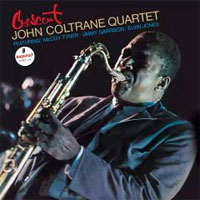John Coltrane Quartet • Crescent Impulse!/Acoustic Sounds AIMP 78301
Recorded in December of 1964, A Love Supreme was Coltrane's biggest seller and the record most familiar to casual listeners. However, if called on to satisfy myself with a single Coltrane album for the rest of time, the title I would choose is Crescent. The year Crescent was recorded, also 1964, was unique in Coltrane’s history. It was midway through the period of his recording with his “classic” quartet at a time when his popularity was at a peak. He was also in the throes of falling in love with Alice Coltrane, whom he had met about a year earlier (and married a year later). The year before, he committed over 70 pieces to tape, and the year after over 80, yet his recorded discography (leaving aside private tapes and overdubs) for 1964 is a mere 33 cuts. Those formed the basis of Crescent and A Love Supreme, along with what was cobbled together as Blue World about a half-century later. According to Alice Coltrane, the two albums her husband returned to the most often were A Love Supreme and Crescent. Blue Note producer Michael Cuscuna is quoted as saying that he was so much under the spell of Crescent that A Love Supreme “never etched into my soul the way Crescent did.” Both albums grew out of Coltrane’s interest in religion and mysticism. He was convinced that music could heal, and he went all out to achieve that end. Coltrane wrote all the albums' compositions, and he provided each of his sidemen a chance to shine. He eschews tenor solos on side two of Crescent, in order to open up space for his sidemen: McCoy Tyner on piano, Jimmy Garrison on bass and Elvin Jones playing drums, one of the greatest jazz groups ever to record. “Wise One,” from Crescent, like the compositions on A Love Supreme, is at the same time a poem, a prayer and a call for peace that resonates more strongly today than ever. Along with the title cut and “Lonnie’s Lament,” these three numbers form the core of an album that is transfixing -- as strong as anything Coltrane recorded. The remaining two cuts, “Bessie's Blues” and “The Drum Thing,” round out a masterpiece. Another thing that Coltrane’s two 1964 masterworks share is that they hold together as albums, rather than as mere collections of songs, a concept that was to be recognized a few years later in pop music with The Beatles. But once again Coltrane was at the vanguard of a movement. Rudy Van Gelder recorded the music on Crescent during two sessions. Unlike Coltrane’s Atlantic albums, where the recordings were captured on both mono and stereo decks, Crescent was recorded in stereo only and released in both mono fold-down and stereo versions. Despite this fact, most collectors preferred the mono versions of the Blue Note and Impulse! titles, because the stereo versions often sounded artificial, with distinct left, right and center zones separated by blocks of dead space. In its early stereo version, Crescent displayed the typical Van Gelder lack of a coherent soundstage, but at least it did not suffer from Van Gelder’s frequent unevenness in recording the piano. Coltrane generally recorded few takes of any given number. The Crescent sessions took place on April 27, 1964, then, on June 1, the group went back into the studio and redid “Crescent” and Billie’s Blues,” and the new versions were used on the final album. Although the overall sound of the three songs used from the earlier April session are superior to that of “Crescent” and “Bessie’s Blues” recorded in June, there is little to fault sonically, except for the somewhat poor soundstage of the early stereo versions. Remastered by Ryan Smith at Sterling Sound, this
reissue, which was pressed at Quality Record Pressings, blends the channels into a
seamless soundstage, one that sounds more natural than that of my original mono pressing.
The analogue tapes used to produce the reissue sound like they remain in very good shape.
I have not been able to confirm whether the original master tapes were lost in the 2008
fire, or whether they were used here, but the resulting sound cannot be seriously faulted.
In some subtle ways relating to air and delicacy, I’d have to give the slight edge to
my original mono pressing, but this reissue’s increase in dynamics and punch, coupled
with the wonderful soundstage and impressive tonal quality, make it the one I’ll
reach for most often. |

 he Acoustic Sounds
Series of releases from Universal Music Group (UMG) moves forward with some very
impressive titles, especially those from the Impulse! catalogue. Some of the master tapes
were thought to have been lost in the 2008 Universal Studios Hollywood back-lot fire that
spread to the “video vault” holding not only movie reels but tapes owned by UMG,
the largest recording conglomerate in the world. For many music lovers, the most precious
titles were those recorded by John Coltrane, the Impulse! label’s bestselling artist.
Impulse! was formed as an offshoot of ABC Paramount Records in 1961. Coltrane went on to
record one of the great bodies of music for the label between 1961 and his death in 1967.
he Acoustic Sounds
Series of releases from Universal Music Group (UMG) moves forward with some very
impressive titles, especially those from the Impulse! catalogue. Some of the master tapes
were thought to have been lost in the 2008 Universal Studios Hollywood back-lot fire that
spread to the “video vault” holding not only movie reels but tapes owned by UMG,
the largest recording conglomerate in the world. For many music lovers, the most precious
titles were those recorded by John Coltrane, the Impulse! label’s bestselling artist.
Impulse! was formed as an offshoot of ABC Paramount Records in 1961. Coltrane went on to
record one of the great bodies of music for the label between 1961 and his death in 1967.